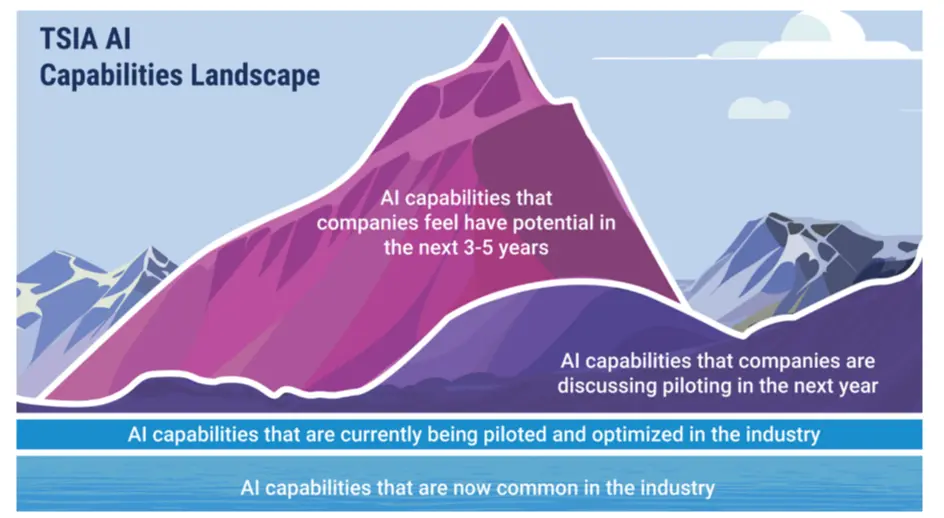AI is actively reshaping how technology companies deliver value to their customers. In support services, AI is revolutionizing how organizations respond to issues, resolve cases, and anticipate customer needs before they even arise.
As part of TSIA’s Research Journey on AI for Predictive and Proactive Support, this case study explores how Dell Technologies leveraged AI and machine learning (ML) to transform its support operations.
Using TSIA’s AI Capabilities Landscape framework to guide classification and benchmarking, Dell’s story demonstrates how practical, well-structured AI applications can deliver measurable results—faster case resolution, higher customer satisfaction, and greater operational efficiency.
Key Takeaways
- AI in support services drives measurable results. Dell achieved significant operational improvements, including faster case closures and higher customer satisfaction.
- Machine learning and information retrieval systems enable smarter, faster resolutions. By using contextual data and feedback loops, Dell’s AI engine continuously refines solutions for support agents.
- TSIA helps benchmark and codify real-world AI use cases. Through research and collaboration, TSIA identifies best practices for technology companies deploying AI at scale.
How TSIA Is Advancing AI in Support
Before diving into Dell’s story, it’s essential to understand the broader context.
TSIA developed the AI Capabilities Landscape, a model for tracking AI adoption across technology organizations. This framework classifies AI maturity into four categories:
- Below the waterline: Common, established capabilities
- At the waterline: Actively piloted and optimized capabilities
- Just above the waterline: Capabilities being explored for near-term pilots
- Well above the waterline: Future-looking innovations expected to emerge in three to five years
TSIA identified Dell’s AI initiative as being “At the waterline,” meaning it’s an active, proven deployment that other companies can learn from.

Through interviews with Erin Kurusz, VP of Service Operations at Dell Technologies, TSIA analyzed how Dell built and refined its AI-driven support infrastructure—and how those learnings can inform broader industry strategies.

Related: TSIA's AI Capabilities Landscape
AI in Support: From Reactive to Predictive
Support organizations have long operated reactively—responding to issues only after customers reported them. Dell wanted to change that.
By investing in AI capabilities, such as machine learning, information retrieval systems, and content summarization, Dell built an intelligent support infrastructure capable of analyzing vast datasets and providing real-time, actionable recommendations.
The company’s AI-powered engine—known as the Next Best Action (NBA) Engine—helps support agents resolve customer issues faster and more accurately. Instead of manually searching for resolutions, agents receive data-informed guidance tailored to each customer’s context.
This system leverages multiple data sources, including:
- Call logs and chat histories.
- Product telemetry.
- Knowledge base articles.
- Diagnostics and resolution alerts.
- Web analytics and system information.
TSIA’s analysis found that this integration of data and automation represented a significant step toward predictive, self-learning support systems. In this area, AI’s potential is only beginning to be realized.
Related: Data’s Crucial Role in Support
Building Dell’s “Next Best Action” Engine
Over an 18-month development period, Dell’s team designed the NBA engine to mimic—and ultimately, enhance—human agent behavior. The system integrates a variety of AI capabilities to:
- Aggregate and analyze content from technical sources.
- Provide step-by-step guidance for faster issue resolution.
- Tailor recommendations to each product line.
- Continuously learn from agent feedback in real time.
The platform is evolving to include next-generation features, such as:
- Persona-based recommendations: Personalized guidance for specific roles.
- Conversational interactions: Integrating voice, chat, and email experiences.
- AI-derived intents: The ability to interpret customer intent through case history and context.
For customers, this means faster resolutions and fewer escalations. For Dell, it translates into reduced costs, fewer hardware dispatches, and more satisfied customers.
Business Impact: Efficiency Meets Experience
Dell’s AI implementation delivered measurable results across multiple support dimensions. For the product lines using this AI capability, TSIA’s research documented:
- Fewer repeat work orders and dispatches
- Reduced parts usage per service call
- Faster resolution times
- Higher customer satisfaction (CSAT) scores
- More software-based fixes rather than hardware replacements
These outcomes show how AI in support services can reduce operational costs while improving both agent efficiency and customer experience. Dell’s model demonstrates the kind of real-world success TSIA aims to share through its Research Journeys—helping member companies see what’s possible, and how to get there.
Lessons Learned From Dell’s AI Journey
Through its interviews and analysis, TSIA identified several key takeaways from Dell’s experience that other technology companies can apply:
1. Create Once, Repurpose Everywhere
Dell developed a single intelligence layer for AI tools that can serve multiple functions—from support agents to self-service customers. This scalable foundation keeps systems unified and efficient.
2. Standardize Product Telemetry
To effectively train AI models, product data must be consistent. Dell worked across teams to standardize telemetry data formats, enabling all product information to feed into a unified intelligence layer.
3. Collaborate Across Teams
AI success isn’t confined to one department. Dell emphasized cross-functional collaboration to reduce duplication and align teams around shared objectives.
4. Educate and Re-Educate Leadership
As organizational structures shift, keeping leadership informed about AI initiatives ensures alignment, funding, and continued progress.
5. Prioritize Value Before Monetization
Dell initially focused on using AI to improve customer experience and reduce costs, rather than selling AI as a product. This built long-term value and loyalty.
6. Integrate Product and Service Teams
By connecting product telemetry with service operations, Dell ensured that AI insights directly informed design, support, and delivery.
AI’s Future in Support and IT Operations
TSIA’s broader research highlights that Dell’s AI journey is just one example of a growing industry shift toward predictive and proactive service.
Tools like Dell’s show how AI is evolving beyond support into full IT operations—monitoring, analyzing, and improving system performance in real time. As AI becomes more embedded in day-to-day service delivery, the most successful companies will be those that combine data-driven decision-making with human expertise.
For organizations looking to follow Dell’s lead, the lesson is clear: AI isn’t just about technology—it’s about transforming how you deliver value.
This case study illustrates how Dell, guided by TSIA’s frameworks and research, turned AI ambition into operational excellence. By embedding machine learning and predictive analytics into support, Dell improved customer outcomes, lowered costs, and established a scalable foundation for future innovation. Dell’s success offers an inspiring blueprint for technology providers aiming to evolve their service models and stay competitive in the AI era.
Related: Harnessing Predictive and Proactive AI in Support
FAQs
1. How did TSIA support Dell’s AI initiative?
TSIA provided the research framework, benchmarking, and analysis through its AI Capabilities Landscape. By documenting Dell’s progress as part of its Research Journey, TSIA helps the broader industry understand how to operationalize AI effectively.
2. What is the most significant benefit Dell saw from adopting AI in support?
Dell achieved faster resolution times, improved customer satisfaction, and reduced operational costs by using AI to guide agents through the most effective next steps.
3. How can other companies replicate this success?
Start by assessing your AI maturity and identifying where predictive and proactive capabilities fit within your service model. Frameworks like TSIA’s AI Capabilities Landscape can help prioritize the right areas for investment.
Smart Tip: Embrace Data-Driven Decision Making
Making smart, informed decisions is more crucial than ever. Leveraging TSIA’s in-depth insights and data-driven frameworks can help you navigate industry shifts confidently. Remember, in a world driven by artificial intelligence and digital transformation, the key to sustained success lies in making strategic decisions informed by reliable data, ensuring your role as a leader in your industry.














